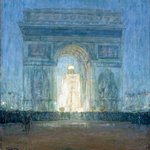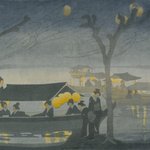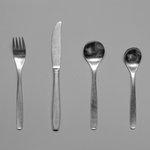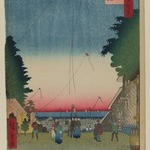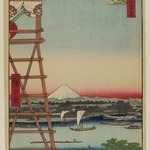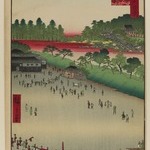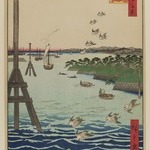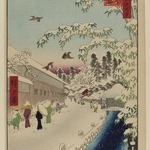
Aoi Slope, Outside Toranomon Gate, No. 113 from One Hundred Famous Views of Edo
Utagawa Hiroshige
Asian Art
Why are two half-naked figures out on such a chilly night? It was customary for artisan apprentices to engage in kan-mairi, wintry nighttime visits to temples and shrines where they would bathe in icy water to temper their bodies and offer prayers to the gods for the refinement of their skills. These two apprentices are returning from a visit to Konpira Shrine, which lay directly behind and to the right. Like the bundled figures on Aoi Slope to the left, they carry lanterns; the lantern of the shorter apprentice bears the name of the shrine god, Konpira Daigongen. The other apprentice also holds a small bell, which he rings as they hurry bravely through the cold.
MEDIUM
Woodblock print
DATES
11th month of 1857
PERIOD
Edo Period, Ansei Era
DIMENSIONS
Sheet: 14 3/16 x 9 1/4 in. (36 x 23.5 cm)
Image: 13 3/8 x 8 3/4 in. (34 x 22.2 cm) (show scale)



MARKINGS
Publisher: Shitaya Uo Ei
SIGNATURE
Hiroshige-ga
COLLECTIONS
Asian Art
ACCESSION NUMBER
30.1478.113
CREDIT LINE
Gift of Anna Ferris
PROVENANCE
Prior to 1930, provenance not yet documented; by 1930, acquired by Anna Ferris of Summit, NJ; 1930, gift of Anna Ferris to the Brooklyn Museum.
Provenance FAQ
CATALOGUE DESCRIPTION
To the left in this view is the Aoi Slope of the title, along which some people, obviously chilled by the cold air, are walking with the aid of their lanterns. The water pouring over the spillway to the right is the overflow from Tameike Pond, which fell into the Outer Moat and passed by the Toranomon Gate (not seen here). The two large barren trees to the left are hackberry trees from which Enoki Slope (further to the left) took its name. At right is Sanno Hill and the gray temple buildings of Sanno Shrine. In the foreground, the two almost naked figures are artisan apprentices; it was their custom at the coldest time of the year to visit temples and shrines at night and bathe in the icy water and offer prayers to the gods for the refinement of their skills. The younger apprentice carries a lantern which bears the name of the shrine god, Konpira Daigongen, while the older one is ringing a small bell. Behind the stray dogs are the portable stalls of noodle vendors, hung with red lanterns. Tameike Pond was drained and leveled in the mid-1880's and Aoi Slope now survives as a street in front of Toranomon Hospital.
EXHIBITIONS
MUSEUM LOCATION
This item is not on view
CAPTION
Utagawa Hiroshige (Japanese, 1797–1858). Aoi Slope, Outside Toranomon Gate, No. 113 from One Hundred Famous Views of Edo, 11th month of 1857. Woodblock print, Sheet: 14 3/16 x 9 1/4 in. (36 x 23.5 cm). Brooklyn Museum, Gift of Anna Ferris, 30.1478.113 (Photo: Brooklyn Museum, 30.1478.113_PS20.jpg)
IMAGE
overall, 30.1478.113_PS20.jpg. Brooklyn Museum photograph, 2023
"CUR" at the beginning of an image file name means that the image was created by a curatorial staff member. These study images may be digital point-and-shoot photographs, when we don\'t yet have high-quality studio photography, or they may be scans of older negatives, slides, or photographic prints, providing historical documentation of the object.
RIGHTS STATEMENT
No known copyright restrictions
This work may be in the public domain in the United States. Works created by United States and non-United States nationals published prior to 1923 are in the public domain, subject to the terms of any applicable treaty or agreement.
You may download and use Brooklyn Museum images of this work. Please include caption information from this page and credit the Brooklyn Museum. If you need a high resolution file, please fill out our online application form (charges apply).
The Museum does not warrant that the use of this work will not infringe on the rights of third parties, such as artists or artists' heirs holding the rights to the work. It is your responsibility to determine and satisfy copyright or other use restrictions before copying, transmitting, or making other use of protected items beyond that allowed by "fair use," as such term is understood under the United States Copyright Act.
The Brooklyn Museum makes no representations or warranties with respect to the application or terms of any international agreement governing copyright protection in the United States for works created by foreign nationals.
For further information about copyright, we recommend resources at the United States Library of Congress, Cornell University, Copyright and Cultural Institutions: Guidelines for U.S. Libraries, Archives, and Museums, and Copyright Watch.
For more information about the Museum's rights project, including how rights types are assigned, please see our blog posts on copyright.
If you have any information regarding this work and rights to it, please contact copyright@brooklynmuseum.org.
RECORD COMPLETENESS
Not every record you will find here is complete. More information is available for some works than for others, and some entries have been updated more recently. Records are frequently reviewed and revised, and we welcome any additional information you might have.


